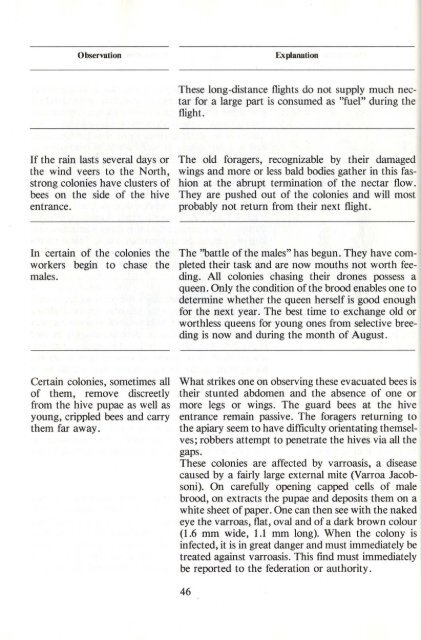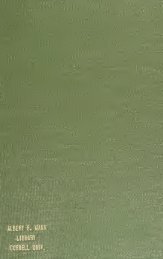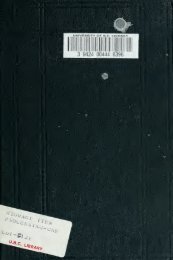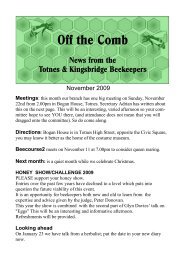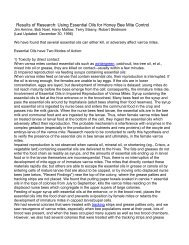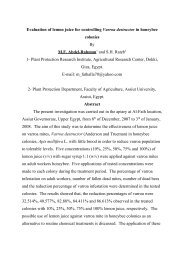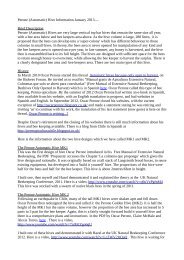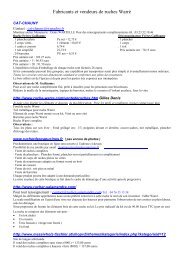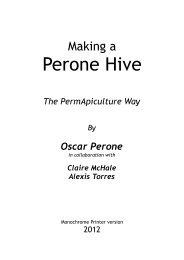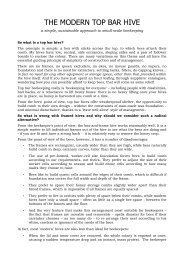You also want an ePaper? Increase the reach of your titles
YUMPU automatically turns print PDFs into web optimized ePapers that Google loves.
Observation<br />
Explanation<br />
These long-distance flights do not supply much nectar<br />
for a large part is consumed as "fuel" during <strong>the</strong><br />
flight.<br />
If <strong>the</strong> rain lasts several days or<br />
<strong>the</strong> wind veers to <strong>the</strong> North,<br />
strong colonies have clusters of<br />
bees on <strong>the</strong> side of <strong>the</strong> hive<br />
entrance.<br />
The old foragers, recognizable by <strong>the</strong>ir damaged<br />
wings and more or less bald bodies ga<strong>the</strong>r in this fashion<br />
at <strong>the</strong> abrupt termination of <strong>the</strong> nectar flow .<br />
They are pushed out of <strong>the</strong> colonies and will most<br />
probably not return from <strong>the</strong>ir next flight.<br />
In certain of <strong>the</strong> colonies <strong>the</strong><br />
workers begin to chase <strong>the</strong><br />
males.<br />
The ''battle of <strong>the</strong> males" has begun. They have completed<br />
<strong>the</strong>ir task and are now mouths not worth feeding.<br />
All colonies chasing <strong>the</strong>ir drones possess a<br />
queen. Only <strong>the</strong> condition of <strong>the</strong> brood enables one to<br />
determine whe<strong>the</strong>r <strong>the</strong> queen herself is good enough<br />
for <strong>the</strong> next year. The best time to exchange old or<br />
worthless queens for young ones from selective breeding<br />
is now and during <strong>the</strong> month of August.<br />
Certain colonies, sometimes all<br />
of <strong>the</strong>m, remove discreetly<br />
from <strong>the</strong> hive pupae as well as<br />
young, crippled bees and carry<br />
<strong>the</strong>m far away.<br />
What strikes one on observing <strong>the</strong>se evacuated bees is<br />
<strong>the</strong>ir stunted abdomen and <strong>the</strong> absence of one or<br />
more legs or wings. The guard bees at <strong>the</strong> hive<br />
entrance remain passive. The foragers returning to<br />
<strong>the</strong> apiary seem to have difficulty orientating <strong>the</strong>mselves;<br />
robbers attempt to penetrate <strong>the</strong> hives via all <strong>the</strong><br />
gaps.<br />
These colonies are affected by varroasis, a disease<br />
caused by a fairly large external mite (Varroa Jacobsoni).<br />
On carefully opening capped cells of male<br />
brood, on extracts <strong>the</strong> pupae and deposits <strong>the</strong>m on a<br />
white sheet of paper. One can <strong>the</strong>n see with <strong>the</strong> naked<br />
eye <strong>the</strong> varroas, flat, oval and of a dark brown colour<br />
(1.6 mm wide, 1.1 mm long). When <strong>the</strong> colony is<br />
infected, it is in great danger and must immediately be<br />
treated against varroasis. This find must immediately<br />
be reported to <strong>the</strong> federation or authority.<br />
46


